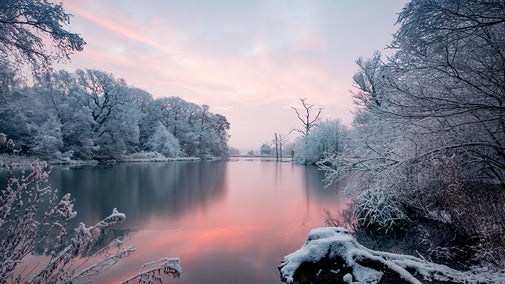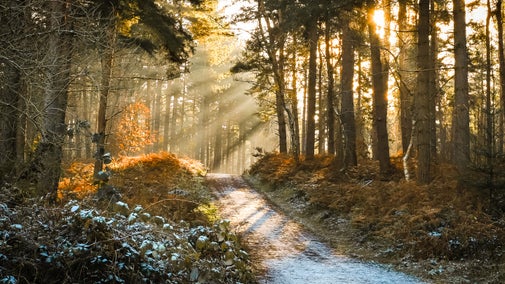Replacing the Hardwick Ford Footbridge
- Published:
- 22 May 2023
- Last updated:
- 04 September 2023

Jump to
After an extensive historic building consent and planning process, we are delighted that work has started on the replacement Hardwick ford footbridge, which was significantly damaged in August 2020.
Said to be longest ford in Nottinghamshire, historic maps of the area show a crossing at this location since the late 19th century, however, it is likely that the ford is earlier than this.
The work, which is being managed by York-based Pinnacle Conservation Ltd, is expected to take around 12 weeks with all works being completed by the end of August.
The bridge will reopen to visitors from lunchtime on Friday 1 September.
The new bridge
Constructed from oak, the bridge components have been crafted here on the estate at Clumber Park by the National Trust In-house Specialist Crafts team. The bridge’s ironwork has been handmade by local Blacksmiths, Mather of Tibshelf.
Sections of the bridge will be transported from the workshop to Hardwick and the bridge will be pieced together on site. The new bridge will be much wider than the previous structure and will provide greater access for mobility vehicles, wheelchairs, cycles and buggies.
Please note: all cyclists and horse riders should dismount using the mounting blocks. Cyclists should walk their bike across the bridge. Riders should walk across the bridge while leading their horse through the water. For safety reasons, please do not cycle or ride across the bridge.
The importance of the time of year
Ecology plays a huge part in determining timings for a project like this, and there are many factors that must be taken into consideration during the planning stages.
June, July & August was identified as the optimum window to not only safeguard nature but to work alongside it successfully ensuring it is protected for future generations to enjoy.
Considerations
- Part of the ford will need to be dammed to direct water away from where work takes place. During the summer months, water levels are at their lowest so the flow of water is more easily controlled and the risk of flooding is minimised.
- The young eels that move upstream in early spring have now migrated to the top end of the lake and won’t be affected by the work taking place.
- The impact on nesting birds has been dramatically reduced. The Ranger team have been busy over recent months clearing reeds to discourage birds from nesting. If wildfowl had built their nests in this area, the start of the project would be delayed until after the nesting season. Once the bridge is in place, the reeds will grow back, water insects will recolonise and birds will return to nesting by the ford.
Mounting blocks
As horse riders must lead their horse through the ford, and not allow them to cross the bridge, there will be mounting blocks which sit at either side of the bridge.
Approximately 2380kg of stones will be used to construct the mounting blocks and the stone selected is Magnesian Limestone (Cadeby Bed 6) from Cadeby Quarry in Doncaster. The mounting blocks will be lifted with a combination of modern nylon lifting straps in conjunction with a very old lifting technique, believed to have been developed when the Egyptians were constructing the pyramids, using Lewis Pins.
The stone will be tooled on their exposed ‘sky surfaces’ to create a suitable surface to stand on.
Maintenance
While the bridge work is taking place, the contractors will also have the opportunity to repoint the cobbles which the ford flows across and rebuild the path and the ramp which sits up to the bridge.
The project in pictures
Follow the progress of the project through images taken by the team.
Thank you for your support
As Europe’s largest conservation charity, the National Trust looks after nature, beauty and history for everyone to enjoy. It is done with the help of millions of members, volunteers, staff and donors. Without this, we couldn’t care for our special places and would like to thank you for your continued support.
If you would like to donate to future conservation projects, please text CLUMBER to 70525 to donate £5.
*Terms and conditions. You will be charged £5 plus one standard rate message. The National Trust will receive 100% of your donation. You must be aged 16 or over to send a text donation. Please make sure you have the bill payer's permission before donating. The SMS service is being provided for the National Trust by Fonix Mobile PLC, 23 Heddon Street, London, W1B 4BQ. Full terms and conditions and our Privacy Policy can be found on our website at nationaltrust.org.uk National Trust 2023. The National Trust is a registered charity, no. 205846.
Contact us
If you have any queries regarding this project, please contact us:
You might also be interested in
Our work outdoors at Clumber Park
Grade I listed park, Clumber Park is a special and important place. Our conservation work focuses on restoring the park's historic landscapes and protecting rare habitats for the future.

The history of Clumber Park
Discover the grand past of Clumber Park; as a hunting ground for royalty, under the care of 13 Dukes and its connections to the Second World War.

Visiting Clumber Park
With 3,800 acres of parkland to explore, there's so much to see and do at Clumber Park this autumn.























